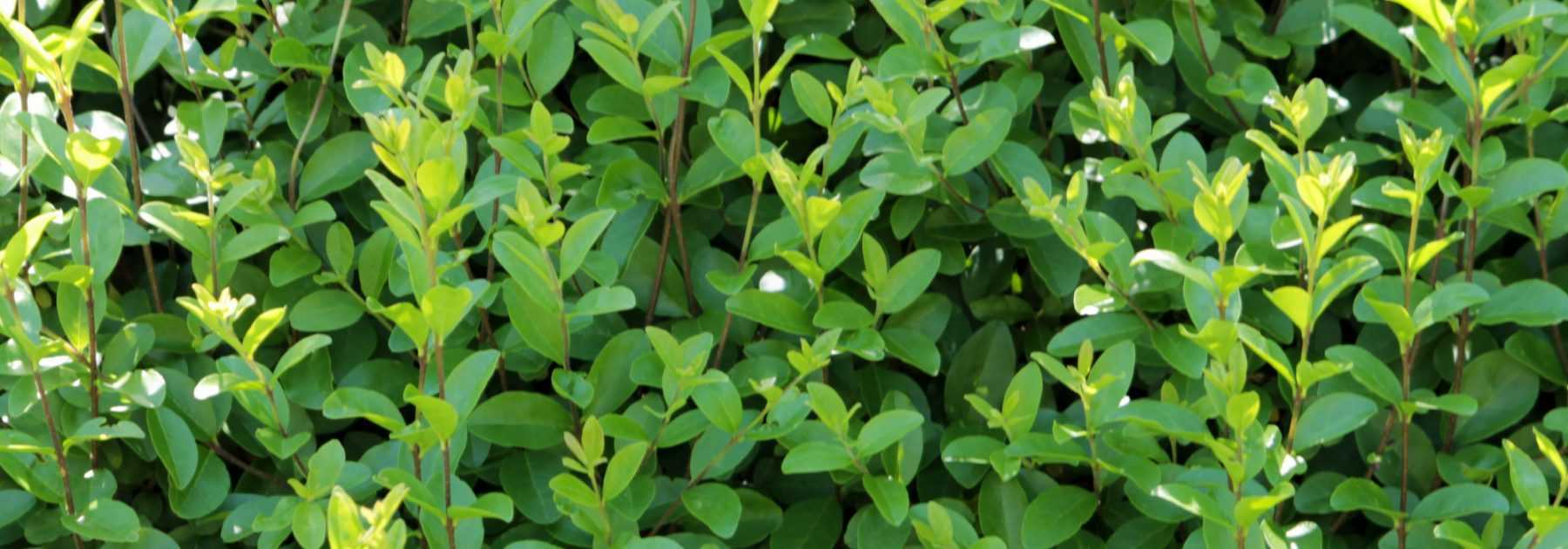
Privet, Ligustrum: planting, pruning and care
Contents
Privet, in a few words
- Privets form small bushes or large shrubs with rapid growth.
- They are evergreen or semi-evergreen, offering not only their glossy dark green hue but also various variegated forms.
- They are well-suited to small gardens as hedges or background plantings in flower beds.
- Privets respond well to repeated pruning and can be used to create topiaries or even bonsai.
- Very hardy, they tolerate all types of well-drained soil, even chalky ones, full sun as well as partial shade, and withstand pollution.
Our expert's word
The Privet or privet, Ligustrum in Latin, is a bush or small tree often used to create hedges. With rapid growth, undemanding nature, and easy cultivation in any not-too-dry soil, it withstands repeated pruning perfectly. It can also be planted in shrub borders and allowed to grow freely. It deserves more frequent use as a standalone specimen, whether pruned or in natural form, or within mixed borders. The foliage, as well as the flowering and fruiting in the form of glossy black berries, are all attractive features worth exploiting.
There is a great variety of foliage, deciduous or evergreen, always lush, shiny, and of fairly modest size, so privet can integrate equally well into shrub borders or perennial plantings, rock gardens, low or medium hedges, or even terrace or balcony displays. To brighten a shady area or draw attention, there are variegated forms like Ligustrum ovalifolium ‘Aureum’ but also more subtle green-leaved varieties that light up through the seasons, such as the cultivar ‘Lemon Lime’ or Ligustrum vicaryii.


Privet foliage: Ligustrum ovalifolium ‘Aureum’, Ligustrum japonicum, Ligustrum x ‘Vicaryi’, Ligustrum vulgare ‘Atrovirens’, Ligustrum ibota ‘Musli’.
Their flowering, more or less spectacular depending on the species, is always melliferous, distinctive for its honey-like fragrance, which attracts many pollinating insects such as butterflies and bees. The presence of privets in the garden thus encourages biodiversity, and they are also attractive to birds in autumn, providing them with shelter and food.
Ligustrum lucidum is a fast-growing tree species that tolerates drought well and forms an interesting small evergreen shade tree, particularly in Mediterranean regions. It self-seeds prolifically thanks to its abundant fruiting.
Description and botany
Botanical data
- Latin name Ligustrum sp.
- Family Oleaceae
- Common name Privet
- Flowering depending on variety, between April and September
- Height between 1.50 m and 6 m
- Exposure sun or partial shade
- Soil type all types of well-drained soils
- Hardiness Excellent to average
Primarily native to Asia, the genus Ligustrum can also be found in Europe, North Africa and even Australia. It comprises around 50 species, most of those selected for gardens (japonicum, ovalifolium, sinense, lucidum, obtusifolium) being of Asian origin, particularly from Japan, China and Korea. Only the species vulgare is native to Europe, but its range extends to temperate Asia and North Africa.
Privets belong to the Oleaceae family, along with Olive trees, Ash trees, Forsythia and Jasmine. Ligustrum lucidum forms a tree up to 15-20 m tall in the wild, while most other cultivated species are bushes ranging from 1 to 3 m tall at ripeness and which tolerate pruning well.
Among the notable features of the Ligustrum genus are the entire, opposite leaves, oval or obovate (wider in the upper part of the lamina), with a very prominent central vein. The glossy leaves are evergreen in Japanese privet (Ligustrum japonicum) and Chinese privet (L. lucidum), semi-evergreen (evergreen in mild climates) in common privet Ligustrum vulgare, California privet (L. ovalifolium) and L. sinense, or strictly deciduous in other species.
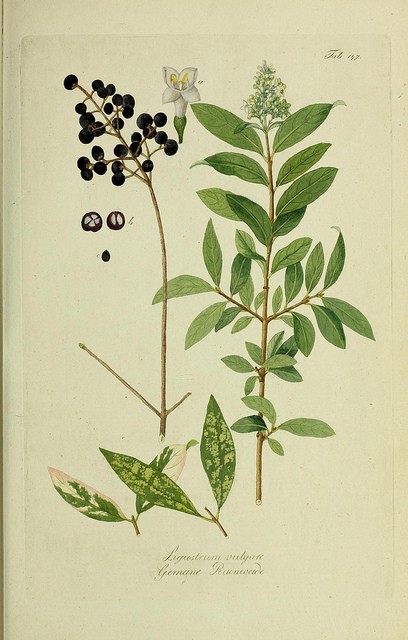
Ligustrum vulgare – botanical illustration
They measure between 2 and 10 cm long. L. vulgare ‘Lodense’ is a semi-evergreen form with fine foliage that turns bronze in autumn. It is highly prized for low hedges or topiary as it has slow growth and creates attractive domes 1 m tall. The leathery, well-rounded leaves of L. japonicum ‘Rotundifolium Aureum’ are dark green margined with gold and take on a lovely green and pink hue in spring and autumn. L. japonicum ‘Texanum’ has leathery, undulate leaves while Ligustrum ibota Musli features foliage variegated with cream, particularly luminous.
The small tubular flowers grouped in more or less abundant inflorescences, 2 to 15 cm long, have 4 fused sepals, 4 waxy-looking petals, 2 stamens that diffuse abundant pollen and a bifid pistil. The flowers are generally cream-coloured but have a purple tip in Yunnan privet (L. delavayanum). The sinense species is particularly attractive when flowering with its weeping habit and long, fragrant white clusters. Beware, the pollen can be allergenic for sensitive individuals. As privet flowers on the current year’s wood, it is advisable to prune just before the clusters open.
The clusters of black-purple fruits stand out against the foliage in autumn and winter. These are small stone fruits, about 1 cm, toxic to humans and pets but much appreciated by birds who find both shelter and food in them.
The root system of privets is quite dense and running, making it difficult to grow other plants at their base. Once well established, privet is capable of withstanding periods of drought even though it prefers moist soil.
The genus name for privets is Ligustrum, which comes from the Latin ligare meaning “to bind”, referring to its flexible stems that were used to make ties.


Flowering and fruiting of privets: Ligustrum japonicum ‘Rotundifolium’, Ligustrum ibota ‘Musli’, Ligustrum ovalifolium, Ligustrum vulgare ‘Lodense’.
Read also
Which bushes to replace boxwood?The main varieties
Privet is a more diverse genus than it appears. This bush, essential for structuring the garden, comes in many species and varieties. Of the approximately fifty species of privet, the most common are Ligustrum japonicum and ovalifolium, often used to create hedges. Privet produces hardy decorative hedges, very easy to maintain, more eco-friendly than conifer hedges, with generally rapid growth and good tolerance to pollution.
Less vigorous cultivars and certain species like Ligustrum delavayanum are ideal for adorning a container. The latter has small, shiny green foliage, very dense, allowing its silhouette to be shaped into a ball on a stem or other forms, and to create bonsai. As a standalone, their evergreen or semi-evergreen foliage, variegated with gold or cream, serves as a focal point to highlight flowerings, a staircase or a statue, especially if shaped into topiary.
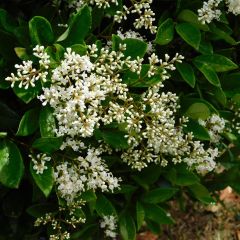
Ligustrum japonicum - Japanese Privet
- Flowering time August to November
- Height at maturity 2,50 m
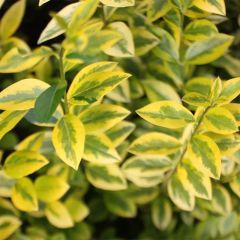
Golden Privet - Ligustrum ovalifolium Aureum
- Flowering time July to September
- Height at maturity 2 m

Common Privet - Ligustrum vulgare Lodense
- Flowering time July to September
- Height at maturity 1 m
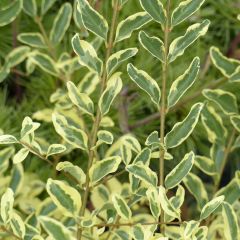
Ligustrum ibota Musli - Privet
- Flowering time July to September
- Height at maturity 2,20 m
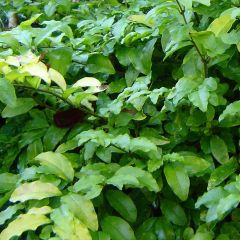
Ligustrum ovalifolium Lemon and Lime - Garden Privet
- Flowering time July to September
- Height at maturity 1,70 m

Ligustrum delavayanum - Privet
- Flowering time June to August
- Height at maturity 1,80 m
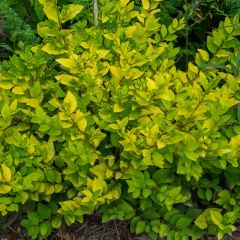
Golden Privet - Ligustrum vicaryi
- Flowering time July to September
- Height at maturity 2 m
Discover other Ligustrum - Privet
View all →Available in 2 sizes
Available in 3 sizes
Available in 2 sizes
Available in 1 sizes
Available in 1 sizes
Available in 1 sizes
Available in 2 sizes
Available in 1 sizes
Available in 1 sizes
Available in 7 sizes
Planting
Where to plant privets?
Privets are not demanding when it comes to soil, they tolerate all types of well-drained soils, even chalky ones or those impregnated with road salt. Plant them in a preferably sunny spot so that the foliage remains compact and the colour more intense, but they also do well in partial shade. Variegated foliage stands out more in the sun but can also help brighten up partially shaded areas.
Note that this bush has great resistance to pollution, making it valuable in urban gardens, as well as to sea spray.
The japonicum species is quite common in Europe as well as North America, but only in regions with mild winters, much like lucidum and sinense. The Yunnan privet (L. delavayanum) is also somewhat delicate and should be planted in a spot sheltered from biting cold. Ligustrum ovalifolium, on the other hand, is much hardier (-28°C) and tolerates chalky soil very well.
When to plant?
Although pot-grown privets can be planted at any time of the year, ideally, it’s best to plant them from October through to March or April. Avoid planting during frost, extreme heat, or when they are in flower. Plant more delicate species in spring after the last heavy frosts, if possible.
How to plant?
Avoid planting privets too close to other plants, especially perennials, as they compete strongly for water and nutrients. However, by keeping a distance of 0.80 to 1.50 m from other bushes, you can easily create a mixed hedge or shrub border with other deciduous species.
Space the young plants 60 cm to 1 m apart to form a privet hedge 1.50 to 2 m tall. Place less vigorous varieties like L. vulgare ‘Lodense’ or japonicum ‘Rotundifolium Aureum’ closer together, as they only spread about 1 m in diameter.
For standalone planting, allow 2 to 4 m of space depending on the species, to showcase its shape. Specimens grown as standards or compact varieties like Ligustrum japonicum ‘Rotundifolium’ make excellent standalone plants, as well as for rockeries or containers.
To plant a privet:
- Soak the rootball in a bucket of water to moisten it thoroughly.
- Dig a planting hole, 50 cm wide and deep.
- Add well-rotted manure or compost.
- Place the plant in the hole.
- Backfill with soil and firm gently.
- Water well.
- Apply a layer of mulch around the base to retain moisture around the roots. This will also help suppress weeds.
Establishment is quick and easy, requiring minimal maintenance.
For container growing, place a 3-4 cm drainage layer at the bottom of the pot (gravel, broken pottery, etc.). Add a mix of 1/3 garden soil, 1/3 compost, and 1/3 coarse sand.
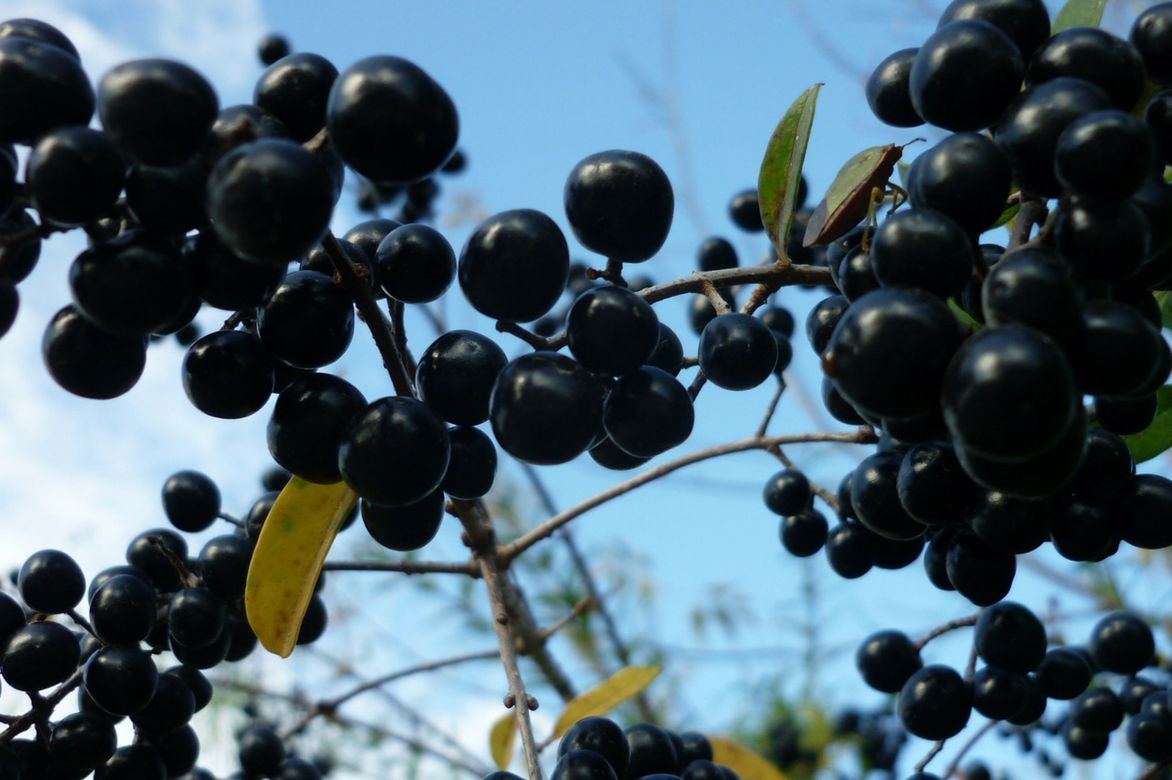
Privets produce decorative berries that are loved by birds.
Read also
Take extra care of your evergreen shrubsMaintenance and pruning of privet hedges
Maintenance
To keep your privets looking their best:
- Renew the compost or manure application every year in spring or from autumn onwards.
- From February to April and from July to September, before the resumption of growth and flowering, prune diseased or dead wood and unruly or tangled branches to maintain a good habit and encourage new shoots.
- Cut back the branches by half to obtain a denser hedge. This is a bush that tolerates repeated pruning well.
- Protect the japonicum species with double winter fleece if the winter is harsh.
Pruning
- Slow-growing species like Ligustrum japonicum ‘Texanum’ are pruned once a year compared to the type species which may require 3 prunings per year. You can prune in August or at the end of winter as the flowers form on the current year’s wood.
- When flowering is not essential, light pruning to maintain the shape of a topiary, for example, can be carried out at any time of the year.
- Use electric hedge trimmers, shears or bonsai scissors depending on the scale of the task. Privet wood is easy to prune as it is neither too hard nor too thick.
- To thicken a hedge that has just been planted, cut back the young plants with secateurs to 30-40 cm from the ground and then twice more during the year, leaving a shoot of 30-40 cm each time. The more often you prune your hedge, the longer the leaves will persist before the frost arrives.
- Remember to check variegated-leaved privets regularly to remove any green shoots that may appear, signs of a “reversion to type”.
Possible diseases and pests
There are relatively few parasitic attacks on privets. However, they are sometimes susceptible to powdery mildew, a fungus that manifests in dry conditions, especially on newly planted bushes. Powdery mildew appears in early spring or late autumn as whitish powdery deposits on the leaves, which eventually fall off. Apply a sulphur-based fungicidal treatment at the first signs of attack, repeating every 10-15 days. During prolonged dry spells, remember to water deeply at the base of each bush, creating a small basin if necessary. Prune the branches and surrounding plants to improve air circulation.
If the leaves show notches, there’s no need to worry, it’s caused by adult vine weevils feeding. You can collect them in the evening under lamplight. These 9mm beetles with a greyish, striate back are recognisable by their long snouts. The larvae, however, pose a real threat to young plants raised in nurseries. They attack the roots and collar during winter. In this case, water the soil with an organic solution of Heterorhabditis nematodes, which parasitise the larvae.
If you notice brownish tunnels and leaves clumped together in cocoons, it’s the work of the lilac leaf miner. The caterpillar of this moth feeds on the internal tissues of the leaf. Remove the cocoons by hand and, depending on the severity of the infestation, apply an organic solution of Bacillus thuringiensis to the foliage, which will kill the young caterpillars.
Propagation: propagation by cuttings
Propagation by cuttings is the most common method for multiplying privet.
They can be propagated by cuttings in spring or autumn.
To begin, prepare a deep pot by filling it with compost mixed with sand, or make your cuttings directly in the ground if it is light, after aerating it with a fork and moistening it.
In autumn:
- Take a lignified shoot about ten centimetres long from a current year’s shoot, ensuring you pull it off at a branching point to retain a small ‘heel’ (the base of the parent shoot). It should be healthy and disease-free.
- Remove the leaves near the base of the cutting and trim the remaining ones to reduce the foliar surface. Leave only a few leaves at the top if they haven’t fallen.
- Autumn cuttings can be planted directly in their final location or in a nursery, possibly protected by a cold frame.
- Insert the cutting about one-third of its length into the soil and gently firm around it to eliminate air pockets and ensure good contact between the compost and the cutting.
In spring:
- Take shoots that have both older and newer leaves.
- Remove the leaves from the lower half of the cutting and cut away two-thirds of the lamina of each remaining leaf.
- Bury half of the cutting in the pot and keep the substrate moist.
- Place under a plastic cover (a transparent sheet held up by stakes and secured with an elastic band around the pot) in a warm, bright spot sheltered from direct sunlight.
- After about a month, roots will have formed, and you can transplant the young plants.
Uses and Associations
A godsend for gardeners lacking inspiration, invaluable for bringing a precise, orderly, reassuring touch to the garden’s structure, the privet has at least the advantage of adding a touch of lushness and life to neglected areas, and why not to abandoned boundaries.
The main use of privet is for creating privacy and windbreak hedges, thanks to the density of its bright foliage, its medium stature, its hardiness, and its great tolerance for repeated pruning. It can also form an 80 cm high border, trimmed into “sausage” shapes, waves, or eccentric forms. It is easy to shape as desired, making it perfectly suited to topiary art and bonsai cultivation.
The base of the bush can be pruned close to the trunk to form a standard or half-standard, very aesthetic when grown in pots. Specimens trained as standards or compact varieties like Ligustrum japonicum ‘Rotundifolium’ and Ligustrum delavayanum make beautiful standalone plants for isolated planting, rockeries, or containers. The latter has small, glossy green foliage, very dense, allowing it to be shaped into a ball on a stem or other forms, trained as bonsai, and even used as an alternative to boxwood, which has been severely affected in recent years.
To brighten a shady spot or draw attention, there are also variegated forms like Ligustrum ovalifolium ‘Aureum’ or more subtle green-leaved varieties that light up through the seasons, such as the cultivar ‘Lemon Lime’ or Ligustrum vicaryii.
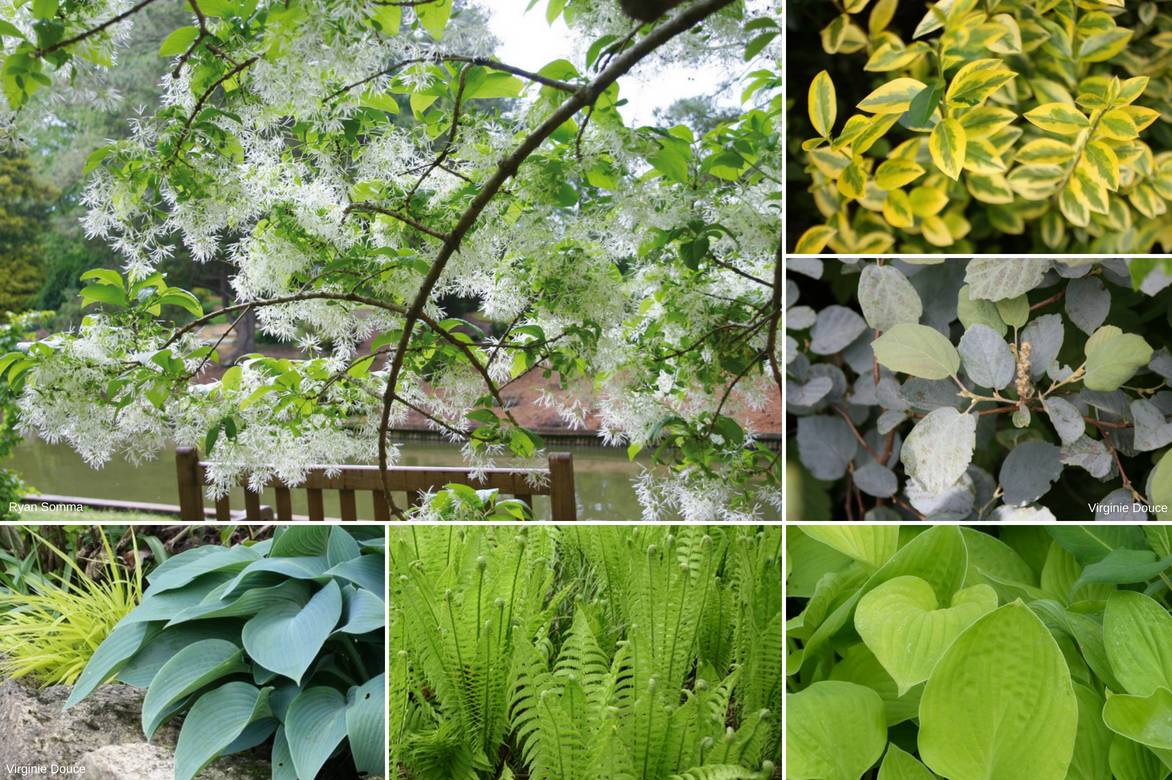

A planting idea for partial shade: Ligustrum ovalifolium ‘Aureum’, Fothergilla intermedia ‘Blue Shadow’, Hosta ‘August Moon’, Matteuccia struthiopteris, Hakonechloa macra ‘All Gold’, Hosta ‘Halcyon’ beneath the canopy of a Chionanthus virginicus.
The shrubby privet will look stunning when paired with other pruned bushes, playing with the shape and colour of the foliage in a graphic, minimalist setting—for example, in a large rockery. It also works very well in group plantings, particularly on a slope where low maintenance is desired.
It can be accompanied by bushes such as Photinia, Eleagnus, St John’s Wort, Kerria japonica, Spiraea, Physocarpus, or Viburnum, or by perennial plants like Daylilies, Verbena bonariensis, Shrubby Sage, and Tree Lupin for a beautiful wildflower scene, allowing its lovely foliage and pleasant flowering to shine when left to grow freely.
You could also honour it by letting it grow freely in a rustic thicket of humble yet highly wildlife-friendly bushes such as Wayfaring Tree, Laurustinus, Cotoneaster, Firethorn, Holly, Eleagnus, deciduous or evergreen Spindle, and Ninebark…


An example of a hedge combination: Physocarpus ‘Lady in Red’, Ligustrum japonicum ‘Rotundifolium’, Viburnum tinus ‘Spirit’, Cotoneaster lacteus, Euonymus planipes.
Finally, don’t forget that Ligustrum lucidum quickly forms a small evergreen shade tree, particularly useful for planting in Mediterranean climates.
Did you know?
The berries of Ligustrum japonicum are used in phytotherapy as a cardiotonic, laxative, diuretic and tonic.
Consumption of privet leaves by horses and ruminants is dangerous. Avoid planting them in areas where these animals roam!
Ligustrum japonicum spreads easily through sowing, sometimes becoming invasive, as seen in the United States. Its introduction in the early 19th century has led to dense undergrowth cover in woodlands and fields, preventing native plants from growing. Moreover, its removal is particularly difficult.
- Subscribe!
- Contents






































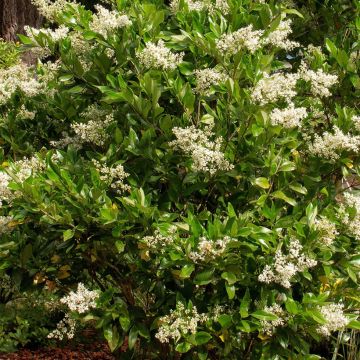
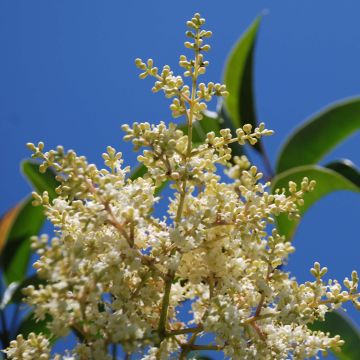
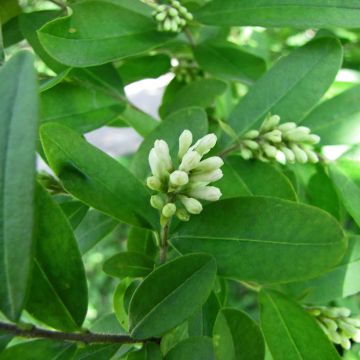
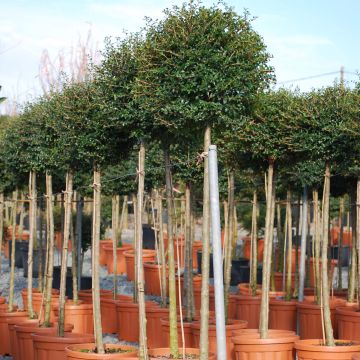
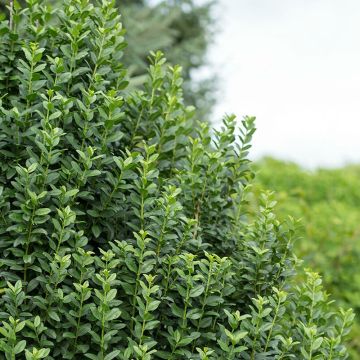
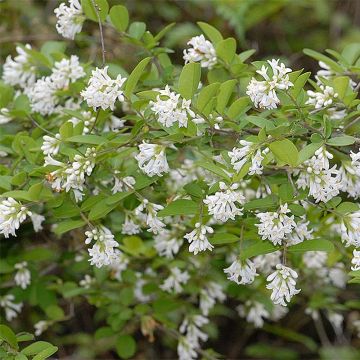


Comments